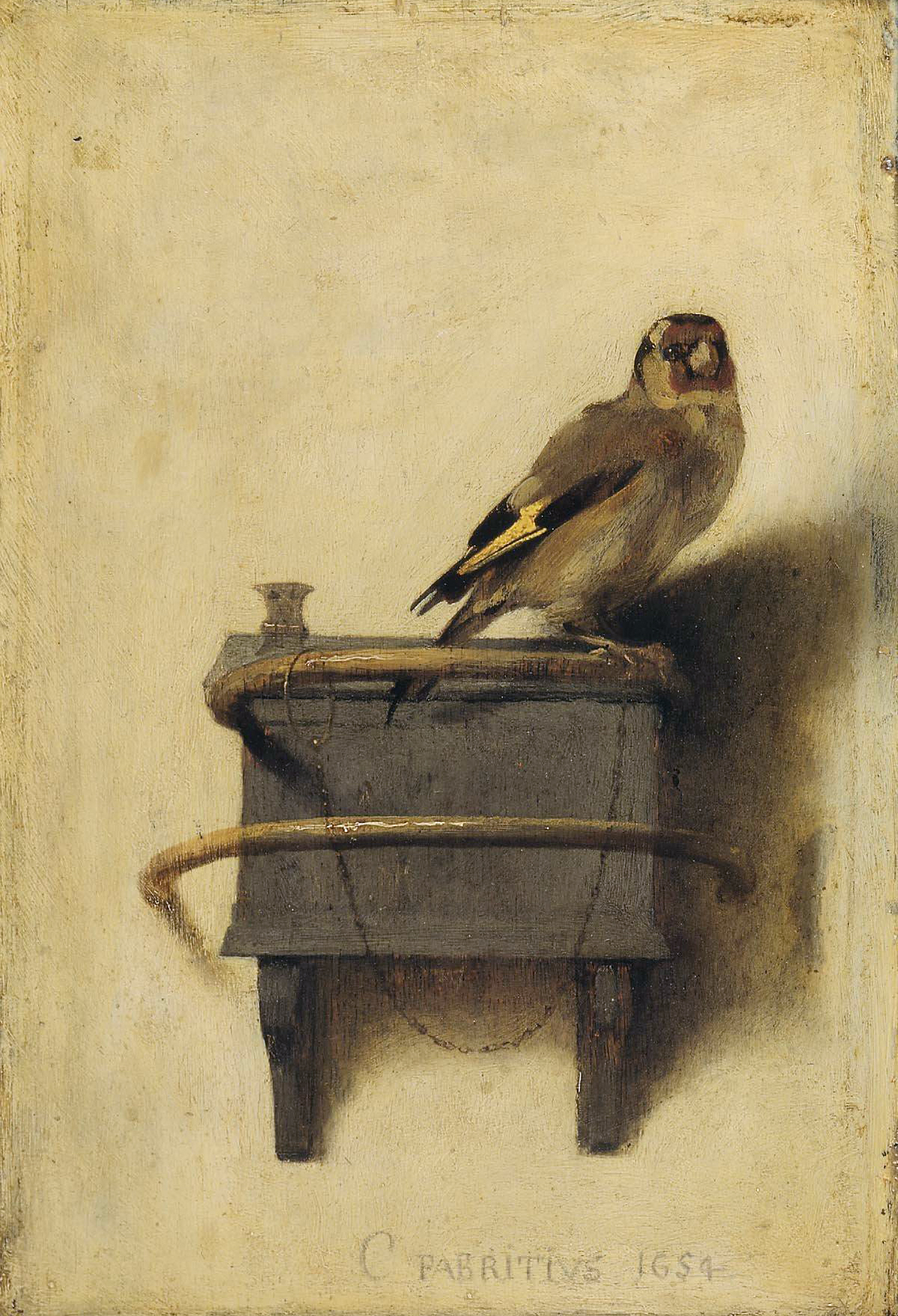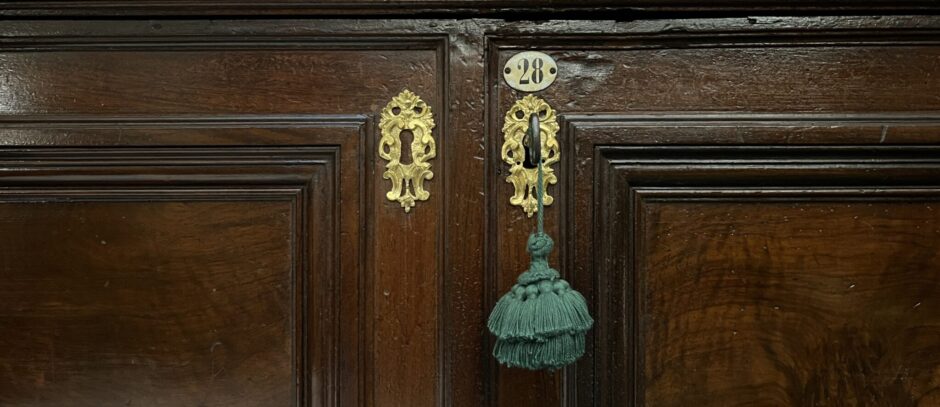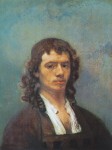 A while ago I was in New York City and I visited, eagerly, the Frick Gallery to see an exhibition of paintings from the Mauritshuis which is making its way around the world: Vermeer, Rembrandt, and Hals: Masterpieces of Dutch Painting from the Mauritshuis. Johannes Vermeer’s Girl with a Pearl Earring was on view.
A while ago I was in New York City and I visited, eagerly, the Frick Gallery to see an exhibition of paintings from the Mauritshuis which is making its way around the world: Vermeer, Rembrandt, and Hals: Masterpieces of Dutch Painting from the Mauritshuis. Johannes Vermeer’s Girl with a Pearl Earring was on view.
However, as interesting as Girl was – I was amused to learn that, during a cleaning, a supposed highlight on the pearl turned out to be a stray flake of something and not Vermeer’s intention at all – I was even more interested in Carel Fabritius’ The Goldfinch.
You know of my interest in what I call “Christological goldfinches” in Italian painting.
I saw today at The History Blog an entry about the Frick exhibit and the Girl and the Goldfinch.
 There I learned of a novel which features The Goldfinch, namely, by Donna Tartt.
There I learned of a novel which features The Goldfinch, namely, by Donna Tartt.
Apparently people are flying and flocking like finches to see the fine feathered feature in numbers as great as those who come to view the Girl with the pearl. They do so, it seems, from their interest in the books. You may also  know about the novel and the movie about the Girl.
know about the novel and the movie about the Girl.
Here is something from the blog entry:
The Goldfinch‘s charm has been more than evident to curators and fans of the Dutch Golden Age for centuries, of course. That’s why it’s included in what is basically a greatest hits exhibition. The petite piece, about the size of a piece of A4 paper, is a trompe l’oeil, a painting that creates the deliberate illusion of reality. A goldfinch stands on a feedbox, a delicate chain tethering him to the spot, against a whitewashed wall with crumbling bits of plaster. The shadows cast by the box are at a fairly steep upward angle and we see the box’s semicircular perches from below, suggesting Fabritius planned the piece for display relatively high on a wall.
Fabritius’ confident, smooth brushstrokes create an incredibly lifelike bird despite the lack of precision photorealistic detail. He learned from the best, studying under no less of a master than Rembrandt in the early 1640s in Amsterdam. You can see Rembrandt’s influence in the splash of yellow in the bird’s wing. Fabritius laid the yellow on thick and then scratched it while it was still wet using the butt of his brush. The scratch exposed the underlying layer of black. This is a technique Rembrandt taught him.
The overall look of the painting, however, is a departure from Fabritius’ early work in Amsterdam. Fabritius was 28 years old when he moved to Delft in 1650 and over time, he moved on from Rembrandt’s dark palette and atmospheric lighting to the brighter scenes and homier subjects of the Delft school of artists. Johannes Vermeer was influenced by this approach (he may have even been an actual student of Carel Fabritius, but the evidence for this is very thin).
Unfortunately Fabritius’ great artistry was severed shortly after he painted The Goldfinch. On October 12, 1654, a gunpowder magazine in Delft exploded, destroying a quarter of the city. Fabritius was killed at the age of 32. His studio was reduced to rumble and most of his paintings were lost. Only a dozen or so of his paintings are known to survive today. It’s possible that The Goldfinch was a witness to this tragedy. When the Mauritshuis restored it in 2003, they found microscopic damage to the surface. It may have been rescued from the rubble.
The Goldfinch, Girl with a Pearl Earring and the rest of the treasures will be on display at the Frick through January 19th, so you have no time to lose if you want to see the exhibition before it leaves the country. There is one more international stop of the tour in the Palazzo Fava in Bologna from February 8th until May 25th, and then the group returns to The Hague in time where they will be installed in the newly renovated Mauritshuis in time for its grand re-opening on June 27th.
I admit that my last trip to NYC was timed partly with this exhibit in mind. I am a fan of Vermeer and of other Dutch masters. The Frick has 3 Vermeer and the Met 5. With the arrival of the Girl with the pearl, there was a serious concentration of Vermeer in NYC. Also on display was a mighty find vanitas painting by one of my faves, Pieter Claesz.



































father z. my last visit to the DIA had the ‘woman with the scale’ Vermeer. It was the last day for it before it went??? It was a joy to see.
Birdie!!!!
Thanks for the painting post, most appreciated.
Birdie!!!
Thanks for the painting post, most appreciated.
Thanks for posting a picture of this Goldfinch, Fr. Z.. It’s very beautiful!
I wonder what the significance is, if any, of painting the Goldfinch tethered to his perch. And I wonder if the artist was Catholic, which if he was, might point toward this particular Goldfinch as having Christological significance. In that case, what might be the meaning behind tethering a Christological Goldfinch? Perhaps the feeder might symbolize the Church, who tethers Her followers to Christ, if they willingly submit themselves to being tethered. The goldfinch in the painting seems content to be tethered and was not painted in such a way as to show any sort of distress. Indeed the finch seems peaceful and serene.
If the feeder might indeed represent the Catholic Church, which is Christ’s Body, then the position of the Christological Goldfinch, placed at the head of the feeder/Church provides further significance.
So many of these Northern artists are immensely talented, but unknown beyond their home country.
When my daughter was married, for the program we debated between two paintings of the Marriage at Cana – one by a 17th c. Mexican artist (another area with a vast number of unsung heroes!) and the second by one Jan Cornelisz. Vermeyen, an early 16th c. Northern painter and engraver. The second intrigued me because he anticipates Caravaggio by almost a century, and because his subjects are so modern in their attitudes and gestures. They could be our friends and neighbors.
http://4.bp.blogspot.com/_Sf0DQN7m2x8/TNbyy5vof3I/AAAAAAAAAyU/hfGNjWzlgIU/s1600/2_Jan+Vermeyen.JPG
My daughter is fluent in Spanish and has a strong Latin American connection, so she chose the Nicolás Correa painting from 1692. He doesn’t have the facility or ‘finish’ of the Vermeyen, but he more plainly “tells the story” and thus it’s more appropriate for a program:
http://newgottland.files.wordpress.com/2012/08/nicolas-correa_wedding-at-cana.jpg
The original is inlaid with chips of mother of pearl and gold leaf.
Naturally, the wedding had absolutely first-class music and lots of it (the rector felt all the Gregorian chant and polyphony PLUS a Mozart Mass setting was a bit much, but we stepped up the tempo a bit and all was well).
My first time to NYC, I made a bee line for the Frick Gallery, a wonderful place. Henry Clay Frick was quite an interesting person with a passion for art.
Beautiful goldfinch! Last year, I came across the cover of an Italian magazine from 1952 – La Domenica del Corriere. Pope Pius XII used to have, amongst other birds, a pet goldfinch called Gretel. Every morning, it would sit on his finger (left hand) while he shaved:
http://www.classe1952.com/1952/DomenicaCorriere/18a_1952_600.jpg
If ever you visit the Netherlands, please contact us. We live but 20 miles from the Mauritshuis and would like to guide you there.
I saw this exhibit in Atlanta in September — it made me want to visit the Mauritshuis. The detail on some of these paintings was unbelievable.
Actually, a mini-post on the symbology of the goldfinch would be fascinating.